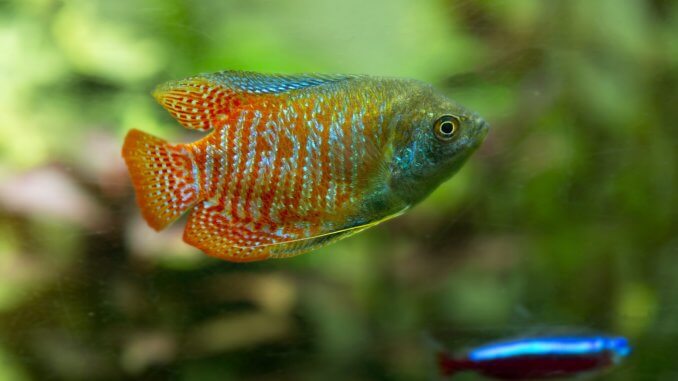
The dwarf gourami is one of the most beautiful aquarium fish, and definitely the most beautiful gourami. Dwarf gouramis continue to rise in popularity among fishkeepers and aquarists.
In addition to their colorful appearance, they are low-maintenance and very hardy.
They exhibit some truly unique behavior, taking down their prey like true hunters.
In this article, we’ll discuss everything you need to know about dwarf gouramis, including how to take care of them, how to choose tank mates, and much more.
TABLE OF CONTENTS
Dwarf Gourami Facts & Overview
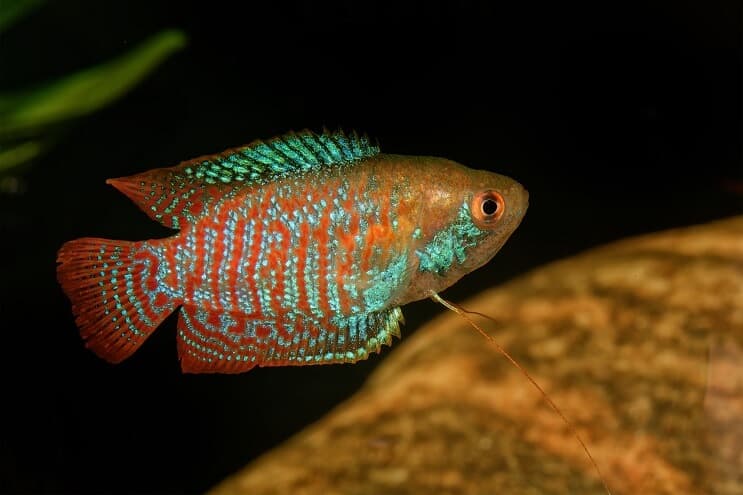
| Category | Rating |
| Care Level: | Easy |
| Temperament: | Peaceful |
| Color: | Multicolored and variable |
| Lifespan: | ~5 years |
| Size: | 4–4.5 inches |
| Diet: | Omnivore |
| Family: | Osphronemidae |
| Minimum Tank Size: | 10 gallons |
| Tank Setup: | Freshwater, heavily planted |
| Compatibility: | Widely compatible |
Dwarf Gourami (Trichogaster lalius), formerly known as Colisa lalia, are majestic looking freshwater fish native to the slow-flowing rivers, ponds, rice fields, and lakes of Southern Asia. However, now they can also be found in the USA, Singapore, and Colombia.
This fish is a member of the Osphronemidae family, more widely known as the gourami family.
Fish from this family are very popular due to their small size and ease of care. On average they live for about 5 years, but under good conditions can live even longer.
You might also know that Gouramis are included in the Anabantiformes order (or labyrinth fish order). Members of this order have a unique lung-like organ that allows them to breathe oxygen straight from the air.
These are schooling fish and prefer to stick together when possible. That way they feel more comfortable and secure. Most of the time they can be found in the middle or top level of the tank. Even in a group they still swim quite slowly and often hide around.
They are generally peaceful fish that should not cause any problems with tank mates. If anything, they are timid and will shy away from boisterous species.
Sometimes males may become protective over females and harass each other, but this won’t escalate if there is enough space.
Keeping just one male in the tank or a couple of females per male is a good preventative measure.
Due to their popularity they can be found almost anywhere; online, in-store, or from fellow hobbyists. As for price, you should expect to pay around $4.
Dwarf Gourami Types
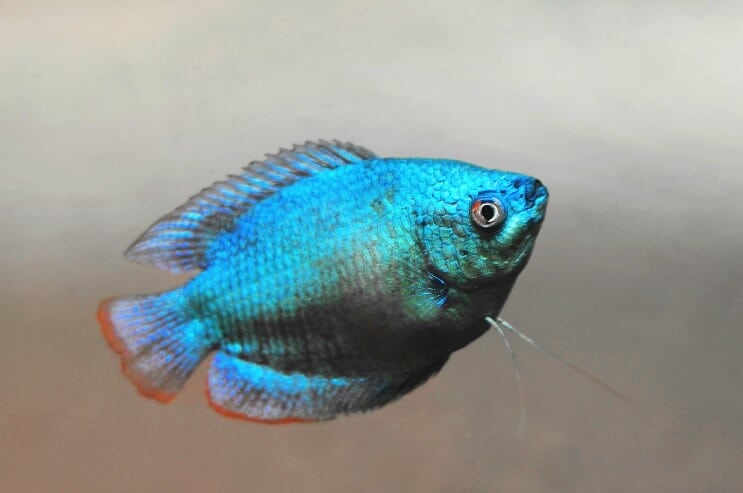
Dwarf gouramis have a truly unique, colorful appearance. As commonly happens with popular aquarium fish, many new mutations have appeared over time, expanding the variety of color even further.
Dwarf gouramis can grow to be up to 4.5 inches in size, but on average most of them only reach around 3.5 inches.
Their bodies are quite narrow and compressed on the sides. Their fins, on the other hand, are large and slightly round. Both their anal and dorsal fins are merged. Their ventral fins have been transformed into a filiform outgrowth which plays the role of a sensory organ.
Identifying the sexes of dwarf gouramis can be difficult, but it is very important if you want to breed them.
Males tend to be slightly slimmer and shorter than females. Female dwarf gouramis will have rounded bellies too.
Their dorsal fin is also a useful indicator. The female’s dorsal fin is shorter and rounder than the male’s, which tapers to a point.
Identifying the sexes of dwarf gouramis gets easier as they age, as juveniles have less developed features.
Here are some of the most popular types of Dwarf Gouramis:
Blue Dwarf Gourami
This fantastically colored fish is one of the most beautiful variations of these species. As their name suggests, blue dwarf gouramis are bright blue and almost glowing. They have distinguishable reddish-brown lines running across their sides and fins.
Their fins also have a light brown edging. Their scales are large, easily recognizable, and are located very close to each other.
Powder Blue Dwarf Gourami
Similar to the blue dwarf gourami, the powder blue dwarf gourami has almost no other colors mixed in and is much brighter than its friends mentioned above. Although this variation isn’t supposed to have anything apart from blue on their body, dark colors sometimes manage to slip in.
Flame Dwarf Gourami
The flame dwarf gourami variation earned gouramis their popularity 40 years ago. After this color mutation, interest in breeding and keeping gouramis shot up.
Looking somewhat like ember tetras, the body of this fish is bright red with an orange gradient. Their fins also have a mix of these two colors.
Neon Blue Dwarf Gourami
The neon blue gouramis retain their beautiful blue color and improve upon it, making it twice as bright and visually striking. They also have red stripes running across their body, which under particularly good conditions may become even brighter and turn the fish into a crazy splash of blue and red.
Honey Dwarf Gourami
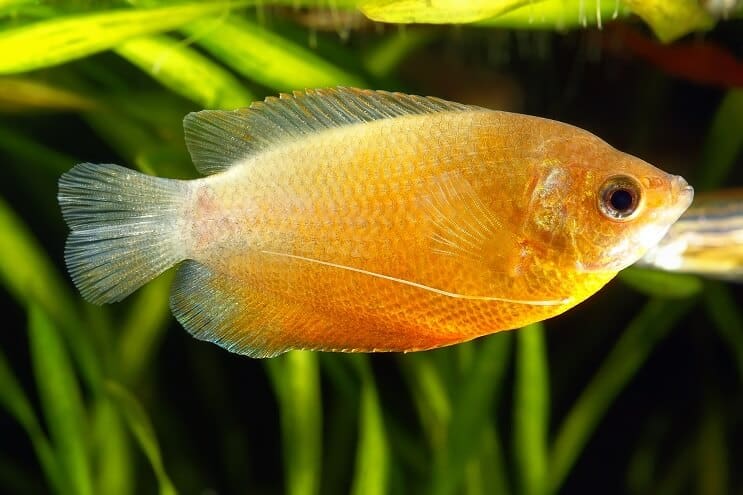
The honey dwarf gourami has a more modest coloring. They are mostly dark red with some orange mixed in. Their caudal fin will almost always be colorless. Their other fins will sometimes have dark patches that in some cases reach the body.
However, you can find honey dwarfs with completely black or grey heads.
Habitat and Tank Conditions
These fish prefer relatively small, slow-flowing bodies of water with densely planted beds. They inhibit all sorts of canals, ponds, rivers, lakes, creeks, and small rivers.
Monsoon rains allow them to explore new territories by creating small seasonal pools ideal for breeding. They are used to lots of light, heat, and nutrients in these small temporary pools, which make them a wonderful place to live in.
However, when the season is over fish swim back to their permanent habitats.
It is important to mention that dwarf gouramis have adapted quite well to temperature swings. The water they are usually found in heats up and cools down equally as fast, which doesn’t leave much choice but to withstand that.
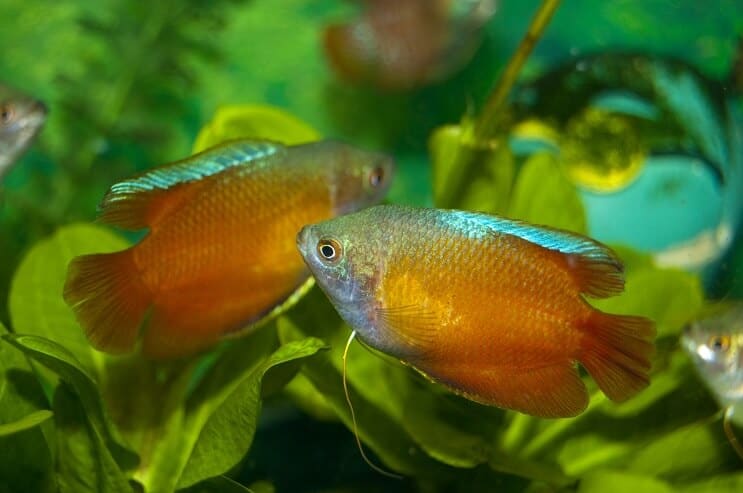
Tank Setup
Substrate for these fish doesn’t play a huge role.
We recommend using a dark substrate as the fish will be visually more striking against it, and they’ll feel more comfortable as well. You can use either well-rounded large grains of sand or small dark gravel.
Although the rivers and ponds they are naturally found in are not sheltered, they don’t like lots of light. Consider just getting a slightly dimmed aquarium lamp and keeping it switched on for 8-10 hours.
Having a good aeration system is a plus but not crucial. The intensity of filtration will depend on the number of plants and the number of fish you have. They prefer slow water flow, so a medium-powered filter will do the job.
As for the plants, free-floating or drifting plants are your best choice. Floating plants with fine leaves, such as hornwort, will help to replicate their natural environment. Gouramis use them to hide in and to build nests in.
Additionally, you can place some ceramics or wood in your tank to give them additional hiding places.
For water parameters:
- Temperature range: 77–78.5°F
- Water hardness: 10–20 dGH
- pH: 6–8
One thing that dwarf gouramis will notice instantly is dirty water. They require weekly water changes of 25–30%.
A clean tank helps them grow as large as possible and stay as healthy as possible.
Dwarf Gourami Tank Size
Two or three gouramis can be easily kept in a 10-gallon tank.
For each additional fish make sure to add 5 gallons.
Tank Mates
Dwarf gouramis are peaceful and tolerant neighbors. They prefer to be placed in a tank with non-aggressive and relatively small fish with similar water chemistry requirements.
Their ideal tank mates would be the bottom or middle level of the tank as that will help to maintain territorial equilibrium and will also liven up your aquarium.
Such tank mates will not disturb them during breeding and will not tamper with their nests if breeding takes place in the community tank. Consider bottom dwellers such as plecos, or other gouramis such as the sparkling gourami or the pearl gourami.
Additional tank mate options for the dwarf gourami include mollies, swordtails, platies, rasboras, loaches, tetras, and catfish such as the otocinclus catfish. Consider adding other non-fish tank mates such as mystery snails and Amano shrimp. Avoid placing very active and fast fish, like barbs, that will create unnecessary competition for food in the tank.
Some people keep dwarf gouramis with a betta. This is possible, but you may spot flaring and signs of aggression because the two species are closely related.
Usually, it’s the larger varieties of gourami that cause problems though.
Keep an eye on newly established fish. If compatibility problems are frequent, you may have to separate the offending fish.
Keeping Dwarf Gouramis Together
Dwarf gouramis can be kept together if the proper ratio of males to females is maintained. Keep at least a couple of females for every male.
Care
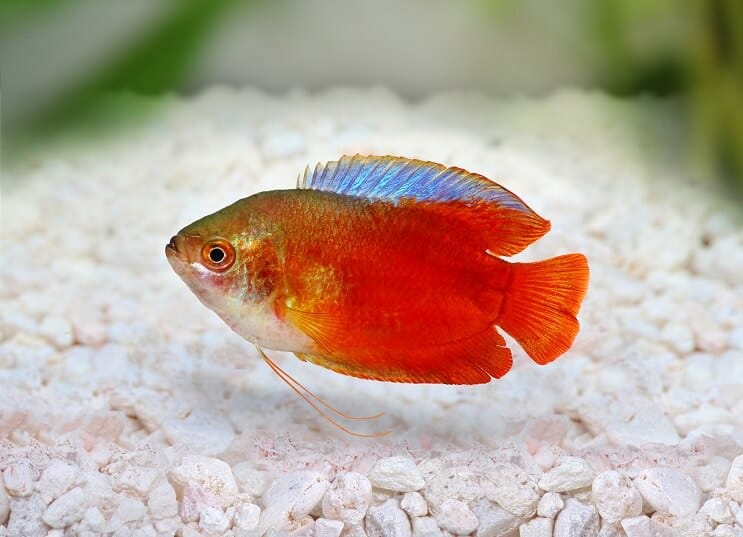
Dwarf gouramis get easily scared by loud noises and will often try to hide. Unfortunately, sometimes this species tends to get into hard-to-reach places and get trapped. The worst-case scenario is that they get stuck and eventually die, so keep an eye out for this.
It’s also important to know that they have an adaptation period. During that period it is especially important not to disturb fish. It’s completely normal for them to act strange or not be very active during that time.
The room temperature and water temperature in the tank shouldn’t significantly differ. In the case that there is a huge difference between the two, gouramis can damage their labyrinth organ. If you find yourself in that situation, place a lid on your tank to trap warm air.
However hardy these fish may seem, they are still very sensitive to water quality. If the quality of their living environment is overlooked, dwarf gouramis can easily get sick.
Below are some illnesses they’re prone to.
Dwarf Gourami Disease
Also known as DGD, this disease is unique to dwarf gouramis.
To date, there are no supplements or other chemicals that can cure this. DGD is a viral infection that can be spotted by fading color and degradation of fin structure (they may just start falling off).
The best way to make sure this doesn’t happen is to monitor the water parameters closely and keep them within the acceptable ranges.
Dwarf Gourami Iridovirus
Iridovirus in Dwarf Gourami (DGIV) is a severe infectious disease that in the majority of cases leads to the death of the fish. As in the case of DGD, there are no known treatments.
Out of all the factors affecting susceptibility to the disease, most can be controlled.
Firstly, water quality is key to having healthy fish. This will ensure that their immune system is strong. Secondly, a good and complex diet is wonderful prevention.
Diet
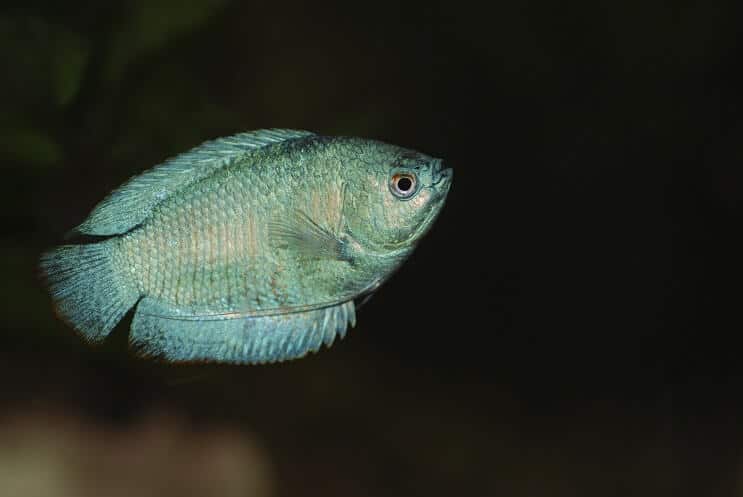
They are natural-born hunters, and they have a very interesting technique.
Dwarf gouramis will hunt insects that fly near the water. First, they swim up to the surface and stay still until they spot potential prey. When the insect gets in their range, they hit them with a spray of water. The unlucky insect falls right into the water with a bunch of hungry gouramis.
They don’t necessarily hunt for everything they eat. If the same insect for some reason ends up in the water by itself, gouramis will gladly eat it.
In the tank, these species happily eat all sorts of foods, pretty much anything that will fit in their mouth. It’s important to use food that doesn’t quickly as most of their feeding takes place in the upper level of the tank.
Dwarf gouramis can be fed live as well as artificial foods. If you are considering buying artificial foods, go for flakes. They usually have a very balanced nutrient and vitamin content. Plant-based foods will also be a great addition to their diet and will help keep your fish healthy.
You can substitute all the nutrients mentioned above with complex pre-made foods, but you need to understand that the size, health, and appearance of your fish rely on a diverse and nutritious diet.
Breeding
Breeding them is a simple and rewarding process.
First, you need to decide whether you want to breed them in a shared tank or a separate one. If you decided to go with the first option, you need to make sure that there are no fish in your tank that will cause problems.
The breeding tank must be exactly like the main one, just slightly smaller. Water temperature should be watched closely, as juvenile fish are much more susceptible to water changes than adults.
The water level should be at around 4–6 inches and the base of the breeding tank should be covered in a thin layer of sand (or any other appropriate substrate).
Dwarf gouramis are ready to reproduce after six months. At that time most mature males begin constructing nests.
First, place future parents in a separate breeding tank. After some time, you will notice that the male starts working on the nest. To stimulate the whole process temperature should be slightly increased (82.5–86°F). All other parameters should be kept in the same range.
Their nests are constructed using foam and saliva. As you can imagine, this doesn’t make a particularly solid structure. That’s why it is important to set the right water flow, a weak flow is less likely to destroy them.
Spawning begins right after the nest is constructed. Females release multiple eggs, which males quickly catch and place into the nest. After spawning has ended, females should be transferred back to the main tank.
The first larvae will appear after 25–30 hours. They will stay in the nest for the next few days.
When the fry starts leaving the nest, the male should be placed back in the main tank. Now it’s important to ensure that fry constantly have food in the tank. You can initially feed the fry infusoria.
After a few weeks, you can introduce cyclops, daphnia, or artemia.
When the fry reaches 0.6–0.8 inches they can be placed in the main tank.
Summary
The dwarf gourami is a sturdy and fascinating fish. Their color variety allows you to turn your tank into a colorful aquatic forest. There are colors and appearance to satisfy any preferences.
They are a great choice for hobbyists with any amount of experience. Their size and resilience make them a wonderful choice for beginners. But they would also be a wonderful addition for experienced aquarists!
If you would like to try your hand at breeding, these fish are your ideal choice. Their breeding behavior is interesting and unique, and the breeding process itself is not complicated at all.
Ultimately, they are among the most beautiful fish you can get.

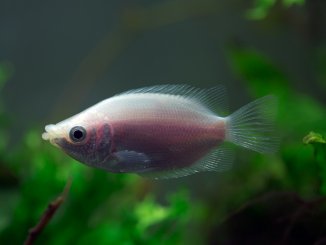
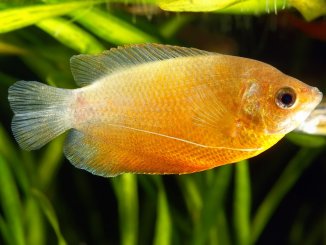
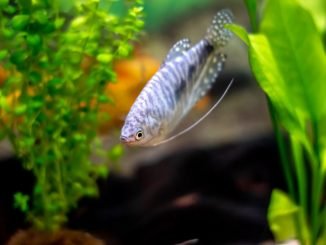
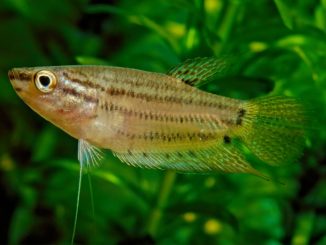
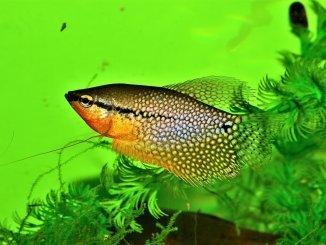
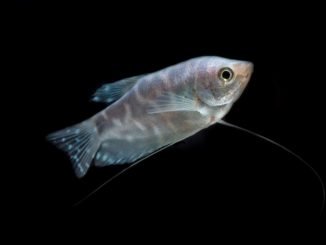
The fish stores around here only sell male dwarf gouramis. Where can I purchase a female or two
Hi Rosamond, I’m not sure where you live, I’ll leave this comment here in case someone in your area can advice you. Thanks, Robert
Why would you want a female? Their colouring is unappealing. Unless you plan to breed you are better off gettin a couple males dwarf gouramis. Male dwarf gouramis are ok to live together.
The males fight with each other ,unless you have a big tank with lots of plants etc
Great information
I have a solo male dwarf gourami who made a nest by pulling out a ton of plants. Not cool! Any tips to avoid the nest building behavior?
How can we tell which are male and which are female?
Great article I’ve just come back to adding these beautiful fish to my community tank after a few years
I want to put 2 Dwarf Gourami, 2 dwarf African frogs, and 2 two dwarf Mexican crayfish in a ten gallon tank with a 15 gallon sponge filter. Would this be overstocked, the right amounts of these species, or can I have more of any of them in the tank?
This would be somewhat overstocked. I’d recommend keeping the ADFs in their own tank dedicated to just African Dwarf Frogs, they do better in groups of 3 or more anyway. I’ve never had luck with keeping them with fish and occasionally found some frogs missing limbs. I think that the crayfish and Gouramis would be okay together, as long as you watch carefully for any fin snipping and clean often.
That would be VERY VERY overstocked. African Dwarfs need 10 gallons by themselves.